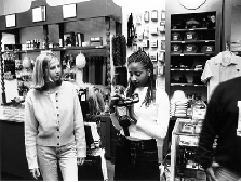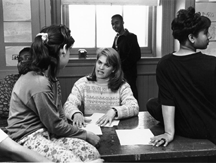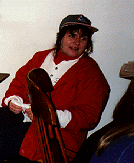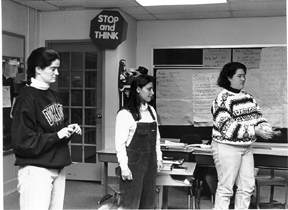
–Hilary Ernsberger and Ayana Ledford produced a video documentary “Boys Zone” from their research in Steelton. This is the site of one of the local businesses where Renee Cook’s 6th grade class conducted research and video taped interviews with a local businessman.
“At the Steelton-Highspire High School not one guy refused an interview because each person rightly believes he “has something to say.” It secured my newfound belief from the memoir component in our course, that everybody has a story. I think from witnessing their explanations and stories, I grew confident that I, also, have a story to share. . . The impact the boys had on me was something I’ll never forget because I felt like I was learning and helping at the same time. Maybe they will remember us as the college girls who got them out of class for a little bit. Or maybe they will really remember us when we become famous Hollywood movie producers and they will say to their wives and children “Those are the two college girls that listened to me.”
“Why did we want to study womyn? Having both survived high school, we know that this can be one of the most difficult times for females. Women are  constantly struggling to fit into the norms of society. How can we be beautiful? We must be tall, we must be thin, we must be white, we must be blonde, we must have shape, we must have big breasts and small waists, we must not have any fat on our bodies, we must be muscular, we mustn’t eat fried foods, fatty foods, sugary foods, too much food. Shall we continue? It is imperative that we study womyn, womyn of different colors and racial/ethnic backgrounds, poverty stricken womyn to the bourgeoisie, so that we can unite and turn this country around together.
constantly struggling to fit into the norms of society. How can we be beautiful? We must be tall, we must be thin, we must be white, we must be blonde, we must have shape, we must have big breasts and small waists, we must not have any fat on our bodies, we must be muscular, we mustn’t eat fried foods, fatty foods, sugary foods, too much food. Shall we continue? It is imperative that we study womyn, womyn of different colors and racial/ethnic backgrounds, poverty stricken womyn to the bourgeoisie, so that we can unite and turn this country around together.
So there we were sitting in our desks at Dickinson College. There we were listening to our anglo-saxon professors tell us about womyn, tell us about difference, deviance, and cultures we wanted to know about. We wanted to hear the African-American voice of the womyn who should have been sitting next to us, but the chairs next to us were empty. When we learned that we could participate in a community study where we would be exposed to a more diverse community than Dickinson, we immediately signed up. Not only would we be able to develop our own research project, we could ask all the questions that we wanted to ask.
For the first time we were able to take what we have learned in the classroom to use for the betterment of the community. Our first step was to simply go into the community and become familiar with our surroundings. By walking down the streets, browsing through shops, and eating in restaurants, we became comfortable enough to emerge ourselves fully into our hight school project. And with some sense of the people that lived in Steelton as well as the businesses that reside there, and the economics and impact that the mill once had, we were able to start talking with people. What have we learned? The females of Steelton Highspire High School struggle not to give into society’s pressures. Some suffer from eating disorders, some feel confident with their reflection in the mirror. Some fight one another over boys, some could care less if they had a boyfriend or not. Some struggle to feed their children, some use their money at a beauty shop. But all of these girls hold promise, all of these girls have beauty. . .They made us want to be teachers, join teen non-profit organizations, join school boards, become president and start a revolution. –Dickinson College Mosaic Students
The One who Slipped Away
“This is a story of a boy named Austin Griffin. The first day I met Austin was in Kendra Hoffman’s fifth period general English class. I can remember my thoughts very clearly when I saw Austin first walk into the room, “Great, this kid is going to cause a lot of trouble,” I thought. As the class discussion for the day unfolded, it turned out that Austin was one of the most soft-spoken people I had ever met. He sat quietly and attentively on the other side of the room, and he only spoke when he was spoken to. I was very interested in meeting with Austin one-on-one in order to hear his story, so I arranged an interview. Well, the interview came and went. It turned out to be one of the most grueling 50 minutes of my life. Austin answered every question with “I don’t know.” What do you want to do when you graduate? “I don’t know.” Well, do you think you would like to continue school or get a job? “I don’t know.” I grew more and more frustrated with this kid as time went on, until it just clicked for me one day. He really didn’t know. In fact, he had no idea what the future was going to hold for him. Well, I thought here’s my chance to make a difference. I can be an inspiration to this kid, I can save him. As time went on, I realized that this was nearly impossible. I began seeing less and less of Austin in school. When he was there, he was always placed in in-school suspension, until one day when he just didn’t come back. After some inquiry, I was soon to be told, “We’ve made other arrangements for Austin.” He was to get his GED, and that was that. I really believed that Austin wanted very much to tell his story that day it was just him and me. But the problem was he wasn’t used to someone listening. He had been abandoned by both of h is parents and now he had been abandoned by the school system. Where will he go now, I wonder. It is for the Austin Griffins of the world, that it is necessary that research like this not only continues, but finds a solution. People need to start listening, because we are losing more and more of our children every day. They are our most valuable resources, and we are letting them slip away.
I hope you find a safe place for yourself, Austin. A place where someone will always listen.
–Angela Yeager, Dickinson Student in the American Mosaic
“After working with the elementary school children every week, attending services at Prince of Peace, going to St. Lawrence lodge, and frequenting the parish’s social functions, it did not take long before I was known by name in the community. I found a lot of truth in Michael Agar’s The Professional Stranger as he described the process of becoming integrated into a community.
Eventually, people come to accept you for what you are–a strange person who asks many dumb questions. Starting from scratch, it seems to take me about three months until some quantum leap occurs, and I am a functioning, accepted member of the community. While you are becoming adjusted, people watch you and find out (hopefully) that nothing harmful happens as a result of your presence. They notice that you do indeed ask questions about language and customs, write things down in notebooks, and tape record interviews (60,61).
 As Agar wrote, it did take some time to really feel comfortable and accepted in the community. People laughed at my questions and made fun of my notebook. By the end of the semester people still teased me about my outsider questions, but I also found my self invited to a Croatian wedding, being forced by one of the women to learn Croatian Kolo dances, and even asked to sit at the head table at a Croatian dance in the parish hall. These are all experiences that I would not have encountered if my project had gone as planned. –Kathleen Rice, Dickinson Student in the American Mosaic
As Agar wrote, it did take some time to really feel comfortable and accepted in the community. People laughed at my questions and made fun of my notebook. By the end of the semester people still teased me about my outsider questions, but I also found my self invited to a Croatian wedding, being forced by one of the women to learn Croatian Kolo dances, and even asked to sit at the head table at a Croatian dance in the parish hall. These are all experiences that I would not have encountered if my project had gone as planned. –Kathleen Rice, Dickinson Student in the American Mosaic
“The transients build fires inside the ranch home that was once mine. J.R. and I meet next to the open furnace in the dark mill next to the abandoned  storefronts on Front Street. There is a truth here, but it is larger than my study can understand. As I walk about I get closer to what I want to say. For now I can only describe it and hope that it will surface from a theory that something has caused a change in the individual and the community. Perhaps it was only a tornado of time moving forward, but I am left here picking up the broken shards of evidence and wondering if others see this rubble too.” –Dixie Palmer, Dickinson Student in the American Mosaic and one-time resident of Steelton.
storefronts on Front Street. There is a truth here, but it is larger than my study can understand. As I walk about I get closer to what I want to say. For now I can only describe it and hope that it will surface from a theory that something has caused a change in the individual and the community. Perhaps it was only a tornado of time moving forward, but I am left here picking up the broken shards of evidence and wondering if others see this rubble too.” –Dixie Palmer, Dickinson Student in the American Mosaic and one-time resident of Steelton.
 “When we entered Steelton-Highspire Elementary at the beginning of our community study, we wanted to find out what was in the hearts and minds of fifth graders growing up in Steelton. One of our main questions was “What do these fifth graders have to tel l us? What are the salient issues from their perspective? Well, now that the semester is over- What do you say about 53 students who have moved into our hearts even as we were “studying” them?” –Alexis Hinchey, Leticia Levy, Stacey Edwards, Kirsten Keville, Dickinson Students in the American Mosaic
“When we entered Steelton-Highspire Elementary at the beginning of our community study, we wanted to find out what was in the hearts and minds of fifth graders growing up in Steelton. One of our main questions was “What do these fifth graders have to tel l us? What are the salient issues from their perspective? Well, now that the semester is over- What do you say about 53 students who have moved into our hearts even as we were “studying” them?” –Alexis Hinchey, Leticia Levy, Stacey Edwards, Kirsten Keville, Dickinson Students in the American Mosaic
“…It is traditional for steelworkers to write their names across the brims of their hardhats. Greg Bowers (vice president of the local union), who has ten children is affectionately referred to as “Baby Maker”. To help us choose, Greg taught us all so me steel-making lingo. Becci selected “Bucket” (where the scrap metal is placed). Samantha picked “Slag” (the residue after the steel is made) and I adopted “Charge” (the sparks and blasts that occur in the furnace if the scrap metal is poured in unevenly). For this reason I purposely wrote my nickname off-center on the brim. As we departed with our new names, our new clothing, and our new experiences, we felt a genuine sense of connection to the workers of the Steelton mill.” –Erica Monheit, Dickinson College student in the American Mosaic
Go back to the American Mosaic homepage